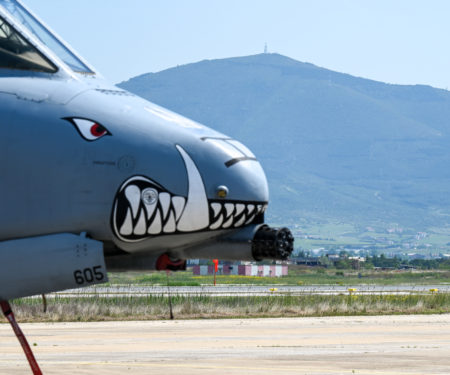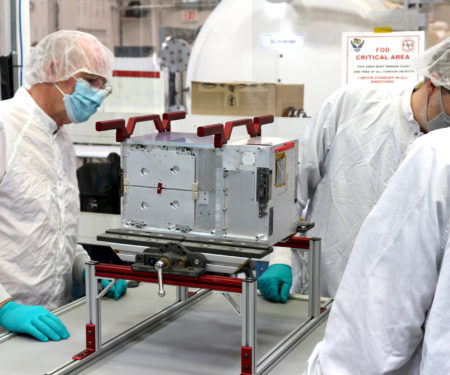Photos: A-10s Back in Europe for NATO’s Defender ’23
New Pentagon Science and Technology Strategy Emphasizes Collaboration with Allies
Why Is the Next Top Enlisted Guardian’s Nickname ‘B-9’?
‘Welcome Home’: Vietnam Veterans to Be Honored on the National Mall
Radar Sweep
US to Provide Ukraine $1.2 Billion in Long-Term Security Aid
The U.S. will provide $1.2 billion more in long-term military aid to Ukraine to further bolster its air defenses as Russia continues to pound Ukraine with drones, rockets and surface-to-air missiles, the Pentagon said May 9. The aid package will be provided under the Ukraine Security Assistance Initiative. Unlike U.S. equipment, weapons and ammunition sent from Pentagon stocks that can be delivered to Ukraine quickly, this money is to be spent over the coming months or even years to ensure Ukraine’s future security needs.
Space Force Reviewing Bids from Satellite Manufacturers for Space Test Program
The U.S. Space Force is reviewing bids from satellite manufacturers competing to produce and integrate experiments for the Space Test Program. Vendors could be selected as early as December for the Space Test Experiments Platform (STEP) 2.0., Lt. Col. Jonathan Shea, head of the DOD Space Test Program at the Space Systems Command, said May 8 during a conference call with reporters.
Blame ‘Global Demand,’ Parts Shortages for Taiwan’s Tardy F-16s, US Says
A strained industrial base and the increased demand for weapons around the world are delaying Taiwan’s promised fighter jets, as congressional frustration mounts over efforts to arm the self-governing island against China. On May 4, Taiwan Defense Minister Chiu Kuo-cheng announced that his government would begin taking delivery of 66 new Lockheed Martin F-16s next year, not in 2023 as planned. Chiu said the ministry has asked the U.S. to “make up the deficiency” and that Taiwan still expects to get all the fighter jets by 2026. The jets, which would add to Taiwan's existing F-16 fleet, were ordered in an $8 billion deal in 2019.
Australian Budget: Historic Defense Spending, Plus AU$1.2B on US-Made Missiles
The May 9 rollout of the Australian budget shows the Australian Defence Force has big plans to buy U.S.-made long-range strike capabilities, as Canberra pursues a strategy to deny an adversary easy access to Australia’s area of interest. Overall, the defense budget for the next year is set at AU$52.588 billion (US$35 billion), the first time funding has exceeded AU$50 billion. That amounts to 2.04 percent of Gross Domestic Product (GDP). Defense spending of two percent of national GDP is an imperfect but widely used benchmark for the adequacy of a nation’s commitment to national defense.
Go Deeper on Operational Imperatives
Virtually every part of the Department of the Air Force’s drive to modernize is being shaped by Secretary Frank Kendall’s seven Operational Imperatives—lines of effort that address the most important and urgent challenges facing the Air Force today. Now, the department and industry are working together to develop solutions for each imperative, and the results will likely change the Air Force and Space Force for the next generation. Keep up with all the latest news on each Operational Imperative.
French Vision for an Autonomous Europe Proves Elusive
After Russia unleashed the largest land war in Europe since the end of World War II, exposing European defense capabilities as lacking, now may not be the best time to fantasize about the continent standing alone militarily. But French President Emmanuel Macron is doing just that, sparking a fresh debate in Europe about where the continent is headed in the grand squeeze among the United States, China, and Russia.
Amphibious C-130 Won’t Fly for Two to Three More Years
An initial U.S. military demonstration of an MC-130J special operations tanker/transport aircraft converted into a floatplane is now two to three years away, at least. U.S. Special Operations Command says it remains interested in exploring this concept as part of its broader interest in new runway-independent aircraft. With large established air bases and their runways expected to be prime targets in any future major conflict, such as one against China, the U.S. military as a whole is increasingly interested in a variety of novel aviation capabilities that make operations from austere locations more feasible.
New DIU Director Wants to Make the Pentagon’s Demand Signal Clear for Commercial Companies
To turn commercial technology into viable products for warfighters, the Defense Innovation Unit (DIU) needs to better communicate its demand signal to industry, according to the organization’s new director. The Defense Department for years has sought to bring in high-tech commercial companies and non-traditional vendors into its acquisition sphere, with ranging degrees of success. Even though there is a renewed desire from the private sector to work with the Pentagon, DIU Director Doug Beck said that the department hasn’t done a good job in communicating its priorities to industry.
How the Space Force Will Manage Surging Launch Demand
The rise of proliferated satellite constellations creates a need for more rockets, and in the last few years, a number of new entrants have ventured into the launch scene—including Firefly Aerospace, Relativity Space, and ABL Space Systems—and more established companies like SpaceX, United Launch Alliance, Blue Origin, and Northrop Grumman have revealed plans to upgrade or build new launch vehicles. Underpinning the swell of commercial and military activity in orbit and the demand for rockets to support it is a launch range infrastructure that is largely managed by the Space Force.
Finding the Fun Despite the Stress of a Military PCS
Comedian and Air Force spouse Ashley Gutermuth has learned to laugh through each successive permanent change of station (PCS) move. Over the course of about 10 moves—effectively "a million," she said—she's even camped out in her recreational vehicle at bases in Virginia and Georgia. Gutermuth was living in San Antonio—in a “Residence, you know, the most glorious of ‘Inns’”—when she joined an episode of the “PCS with Military.com” podcast. Amid stories about her collection of six Roombas and observations on the art of comedy and the ubiquity of commissary chicken shortages, she shared a few tips about finding the funny in military life.





